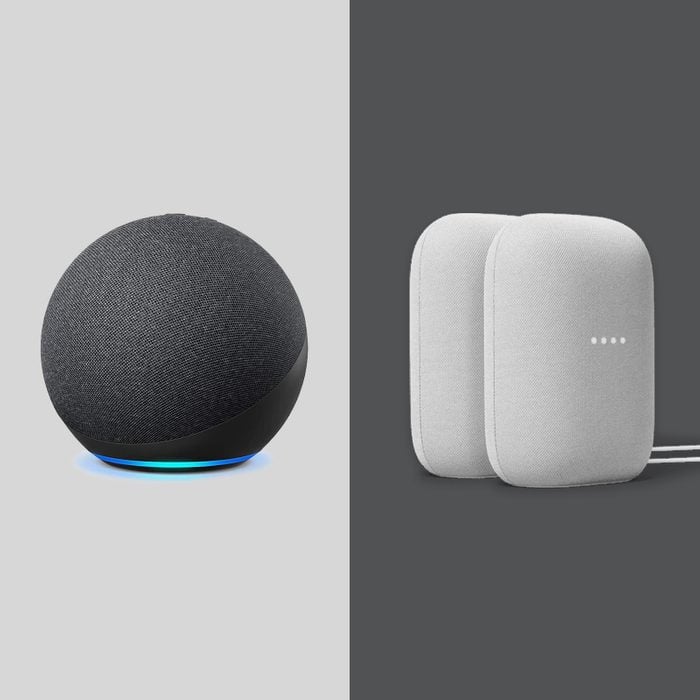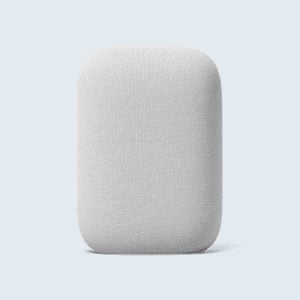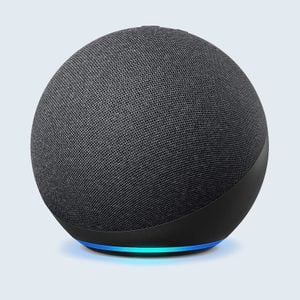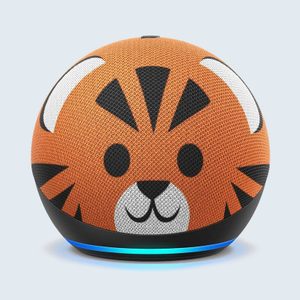Google Home vs. Amazon Echo: Choosing the Right Smart Speaker for Your Home
Updated: Apr. 24, 2024

Choose wisely and you’ll make your life a whole lot easier.
Our editors and experts handpick every product we feature. We may earn a commission from your purchases.
At first glance, Google Home and Amazon Echo smart speakers share many similar features. They can automate smart devices around your home, play music, search for information, tell you the weather, organize your schedule, and much more. But there are still some exclusive perks that set each device apart. Before choosing your new voice assistant smart speaker, consider the following pros and cons of using a Google Home vs. Amazon Echo. And if you go with an Amazon Echo, you’ll also want to learn what Amazon’s Alexa can do, the most useful Alexa skills, how to change Alexa’s name, the funniest things to ask Alexa, and which Alexa accessories you should also pick up.
Voice assistants
For shoppers who want the voice assistant with the highest IQ, Google Home might be the better bet. Research shows that Google Assistant correctly answers questions more frequently than Amazon’s Alexa. In an April 2019 report from market research firm Perficient Digital, Alexa attempted around 50 percent of the questions and answered just over 80 percent of them correctly. Google Assistant, by comparison, attempted to answer nearly 70 percent of the questions and gave correct answers 90 percent of the time. Why? Researchers say it’s mostly thanks to the things that Google Home can do that Echo can’t, like understanding two-part questions and multiple languages.
RELATED: Is Alexa Really Always Listening?
Skills
Amazon Echo has a wider selection of third-party skills than Google Home does, from hailing an Uber or Lyft ride to checking your bank account balance with a simple voice command. Because Echo is made by Amazon, it’s also the only smart speaker that supports shopping on Amazon.com and provides updates on Amazon orders. You can even create custom skills on your Echo using the Blueprints feature. Access Blueprints by opening the Alexa app on your phone and tapping on More > Blueprints. From there, you can create new skills like building an Alexa-accessible chore chart, creating event countdowns, making audio greeting cards or blogs, and organizing an upcoming vacation. Another gadget that has helpful skills: The Amazon Astro Home Robot.
Smart home integration
When it comes to the two speakers’ smart home integration systems, tech experts see very few differences between Google Home vs. Amazon Echo. Alexa uses Blink and Ring for home security because they are owned by Amazon, while Google Home uses Nest, which is owned by Google. However, both systems have similar smart home capabilities, allowing you to create voice-control commands for smart devices like lights and speakers, link up to smart TVs, and combine multiple actions into one command. Google Home does have one perk over Amazon Echo: It is compatible with Google-owned YouTube, so you can access free videos and music with a few taps. No matter which smart speaker you choose, investing in these other smart home devices is worth every penny.
Price
From a cost perspective, the prices of Google Home vs. Amazon Echo devices are virtually the same. The Google Nest Mini costs $49 compared to Amazon’s Echo Dot’s price of $49.99, the larger Google Audio and Amazon Echo both cost $79.99, and the Nest Hub Max costs $229 while the Echo Show 10 costs $249. That said, you can nab an Echo, Echo Dot, or Echo Show on the cheap by waiting for the devices to go on sale. Most Amazon smart speakers are marked down by up to 50 percent during the holiday season and on Prime Day, which will take place on June 21 and 22 this year.
RELATED: The Best Time to Buy 45 Cheap Finds Throughout the Year
Design and aesthetic
You can’t go wrong with either Google or Amazon devices when it comes to design. Both are sleek, stylish, and look great anywhere in the home. If you are picky about colors, the Google Nest Mini offers a wider variety of shades than the Echo does, including chalk, charcoal, sky, and coral. Nest Audio comes in a few additional colors, like sage and sand. The fourth-generation Echo Dot, on the other hand, only comes in charcoal, glacier white, and twilight blue, but the Echo Dot Kids edition includes fun designs like tiger and panda faces.
Voice-to-text recognition
One of the handier features that Echo offers—but Home doesn’t—is its voice-to-text capability. Using Alexa commands, you can send texts to phones without lifting a finger. Just say, “Alexa, send a text message,” and Alexa will guide you through the process. Keep in mind that this feature only works with contacts that have the Alexa app on their phone, though. To see who can be contacted and who cannot, tap on the “Communication” icon, then tap “New Message.” The people you can text will be listed on the screen. Homeowners should also know these amazing Amazon Alexa hacks.
Accessories
While you can play voice games with both Amazon Echo and Google Home devices, only Echo offers game controllers that you can pair with the smart speaker for an extra level of fun. These controllers, called Echo Buttons, can be used to play 100 different Alexa-enabled games like Battleship, Trivial Pursuit, and Simon. Echo also has another accessory that Google Home doesn’t: a remote that is compatible with voice commands. You can use the Amazon Voice Remote to give Alexa commands when you’re in another room and your Echo can’t hear you. The remote is compatible with Amazon Firestick and Amazon Fire TVs, too.
Music streaming
Both Echo and Home devices can stream Spotify, Pandora, Sirius, iHeartRadio, and several other music streaming services. But only Echo can stream music from Amazon Music, Prime Music, and Apple Music, while Home supports Google Play Music and YouTube Red. Google also allows users to upload their own music to its library. Amazon discontinued that service in 2019, which makes it a less attractive option for people with their own personal music collections.
Security
Though it costs extra to add smart home security systems on Google and Amazon devices, the Echo offers a free feature called Guard Mode that acts as a security monitor. Guard Mode can actively listen for strange noises in your home, like breaking glass and alarms from smoke detectors and carbon monoxide detectors, and alert you on your phone. It can also turn smart lights on and off to trick potential intruders into thinking someone is home when you’re away. To set up Guard Mode, open the Alexa app and tap on More > Settings > Guard. From there, the app will guide you through the process of setting up the feature. Learn how Alexa can help during emergencies, too.
Which smart speaker is best: Google Home vs. Amazon Echo?
It’s a neck-and-neck competition between Google Home vs. Amazon Echo, tech experts say. Ultimately, the differences between the two devices are small: Alexa offers a wider variety of skills, for example, while Google’s voice assistant is better at answering questions. For many shoppers, the decision may come down to which perks they use most often. The Amazon Echo is a great choice for Amazon Prime subscribers, but Google Home is a better option for music lovers and frequent YouTube users. Once you settle on a smart speaker, find out which smartphone is most secure: iPhone or Android.
Sources:
- Perficient Digital: “Rating the Smarts of the Digital Personal Assistants in 2019”
- Popular Mechanics: “Amazon Echo vs. Google Nest: Which Smart Home Hub Is Better?”
- PC Mag: “Amazon Echo vs. Google Home: Which Smart Speaker Is Best?”




